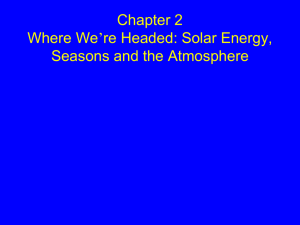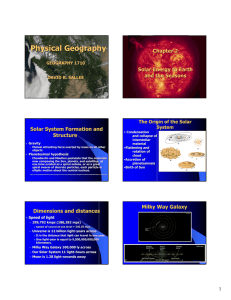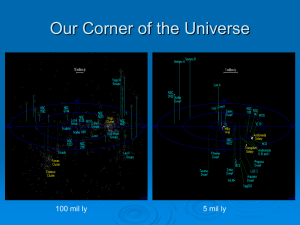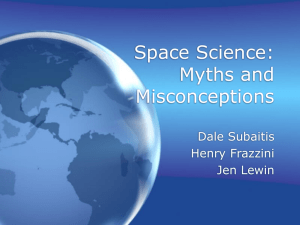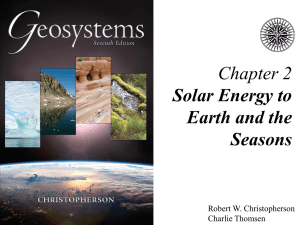geog160_ch02 - Cal State LA
advertisement
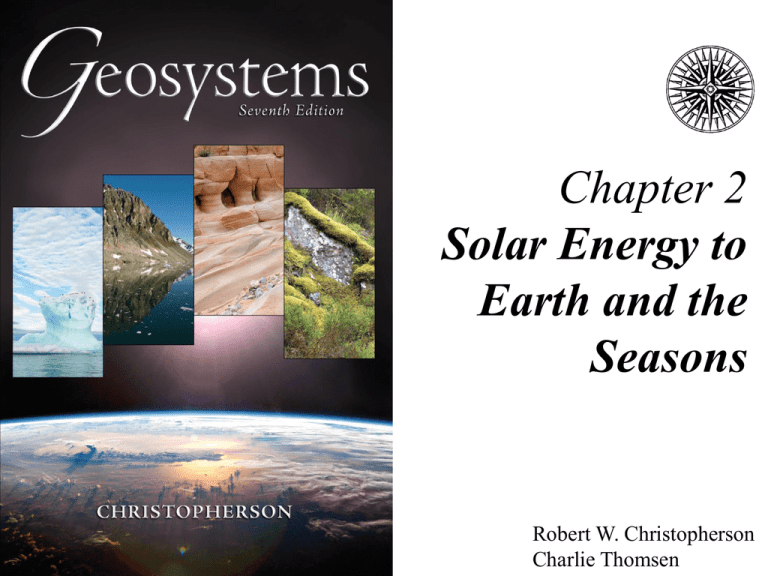
Chapter 2 Solar Energy to Earth and the Seasons Robert W. Christopherson Charlie Thomsen Solar Energy to Earth and the Seasons The Solar System, Sun, and Earth Solar Energy: From Sun to Earth The Seasons Milky Way Galaxy Figure 2.1 Our Solar System Dimensions and Distances Earth’s orbit Average distance from Earth to the Sun is 150,000,000 km (93,000,000 mi) Perihelion – closest distance (at January 3) 147,255,000 km (91,500,000 mi) Aphelion – farthest distance (at July 4) 152,083,000 km (94,500,000 mi) Plane of Earth’s orbit is the plane of the ecliptic Solar Energy: From Sun to Earth Electromagnetic spectrum of radiant energy Intercepted energy at the top of the atmosphere-insolation Wavelength and Frequency Longer wave length, lower frequency, and lower intensity Figure 2.5 The Electromagnetic Spectrum Sun radiates shortwave energy Earth radiates longwave energy The Electromagnetic Spectrum of the sun Ultra Violet: <0.4μm (8%) Visible light: 0.4-0.7μm (47%) Infra-red: >0.7μmb(45%) Figure 2.6 Solar and Terrestrial Energy Figure 2.7 Earth’s Energy Budget Insolation: intercepted solar radiation Solar constant: average value of the insolation received at the top of the atmosphere when earth is at its average distance from the sun Figure 2.8 Distribution of Insolation Tropics receive more concentrated insolation due to Earth’s curvature (higher solar angles) Tropics receive 2.5times more than poles Figure 2.9 The higher the solar angle, the stronger intensity of solar radiation Direct rays: perpendicular to the earth’s surface. The highest solar angle. Direct rays only occur between Tropic of Cancer (23.5N) and Tropic of Capricorn (23.5S). Subsolar point: the only point (latitude) on the earth’s surface that receives direct rays Sun’s inclination: latitude of the subsolar point The Seasons Seasonality Reasons for seasons Annual march of the seasons Seasonality Seasonal changes in Sun’s altitude – angle above horizon 2. Declination – location of the subsolar point 3. Daylength 1. Reasons for Seasons 1. 2. 3. 4. Revolution Rotation Tilt of Earth’s axis Axial parallelism Revolution and Rotation Figure 2.13 Reasons for Seasons 1. Revolution-length of the year Earth revolves around the Sun Voyage takes one year Earth’s speed is 107,280 kmph (66,660 mph) 2. Rotation-length of the day Earth rotates on its axis once every 24 hours Rotational velocity at equator is 1674 kmph (1041 mph) Axial Tilt and Parallelism (Circle of illumination) Figure 2.14 Reasons for Seasons Tilt of Earth’s axis Axis is tilted 66.5° from plane of ecliptic Axial parallelism Axis maintains alignment during orbit around the Sun North pole points toward the North Star (Polaris) Annual March of the Seasons Figure 2.15 Annual March of the Seasons Winter solstice – December 21 or 22 Subsolar point Tropic of Capricorn; shortest daylight hours in NH. Spring equinox – March 20 or 21 Subsolar point Equator; equal daylight and night hours everywhere on the earth Summer solstice – June 20 or 21 Subsolar point Tropic of Cancer; Longest daylight hours in NH Fall equinox – September 22 or 23 Subsolar point Equator; equal daylight and night hours 11:30 P.M. in the Antarctic Figure 2.16 Midnight Sun Figure 2.17 Seasonal Observations Figure 2.18 If the tilted angle is 60 degrees to the plane of ecliptic, where would be tropics and circles? Arctic/antarctic circle=titled angle (60ºN/S) Tropics = 90-titled angle (30ºN/S) Increased tropics area and increased polar areas Larger seasonal variations in most places If the tilted angle is 90 degree to the plane of ecliptic? Circles would be at 90ºN/S Tropics would be at equator No seasonal variation No day length changes
